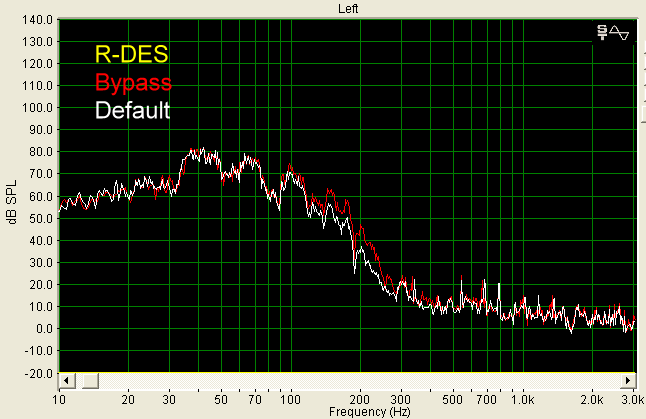Let's assume you have your microphone connected to your
soundcard, and have installed the RTA program, and the R-DES box is
connected to the computer as well as your subwoofer.
You place the R-DES program running in one window
and Visual Analyser 8 (VA-8) in a second window. There is a pink noise
generator in VA-8. You turn that on, look at the spectrum in VA-8, adjust
the EQ bands in R-DES, and upload the curve to the R-DES box (you can upload
the curve while it is running, and watch the changing response in VA-8).
Time saving: about 95% in my estimation.
Here is the VA-8 window, with the uncorrected room
response, and all the settings in the various menus that I used. Try those
at first, then experiment.

Click on the photo above to see a larger
version.
Note that I used a sampling frequency of 8,000 Hz. This
focuses the power of the program in the subwoofer frequencies. Basically,
this means that the 16,386 FFT samples (see the Main Parameter menu of the
photo above where I selected 16,386 FFT samples to be performed) of the
signal are spread throughout the 1 Hz to 4 kHz range (at a digital sampling
frequency of 8 kHz, you can work with analog signals of half that frequency,
i.e., up to 4 kHz). FFT means Fast Fourier Transform, and Fourier Transforms
are mathematical computations to convert the data originally in a time
domain (the musical or test signal) to a frequency domain (a spectrum
showing the peaks of all the frequencies in the original signal). For more
details about FFTs, click
here.
The program that I normally use, called SpectraLab, is
more powerful, but also, expensive ($2,500). However, it does give similar
results, just more quickly. Below is a graph of the Bypass and Default curve
resulting response, using SpectraLab. It is the same shape as the one given in VA-8, and it
should be. The point is that you can get professional results from that
freeware program. I can measure distortion one order of magnitude better
with SpectraLab than with VA-8, and I need that for preamplifier and
amplifier tests (at least, that is what I am telling myself right now - Free
vs. $2,500, whoa!)

Click Here to Go to Part V.